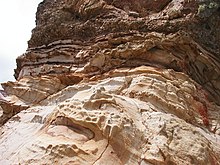
Back Glissement de terrain sous-marin French Longsor bawah laut ID 海底地すべり Japanese Osuwiska podmorskie Polish

Submarine landslides are marine landslides that transport sediment across the continental shelf and into the deep ocean. A submarine landslide is initiated when the downwards driving stress (gravity and other factors) exceeds the resisting stress of the seafloor slope material, causing movements along one or more concave to planar rupture surfaces. Submarine landslides take place in a variety of different settings, including planes as low as 1°, and can cause significant damage to both life and property. Recent advances have been made in understanding the nature and processes of submarine landslides through the use of sidescan sonar and other seafloor mapping technology.[1][2][3]
- ^ Hampton, M & Locat, J (1996) Submarine landslides. Reviews of Geophysics, 34, 33–59.
- ^ Locat, J & Lee, HJ (2002) Submarine landslides: Advances and challenges. Canadian Geotechnical Journal, 39, 193.
- ^ Mason, D, Habitz, C, Wynn, R, Pederson, G & Lovholt, F (2006) Submarine landslides: processes, triggers and hazard protection. Philosophical Transactions of the Royal Society, 364, 2009–39.
© MMXXIII Rich X Search. We shall prevail. All rights reserved. Rich X Search